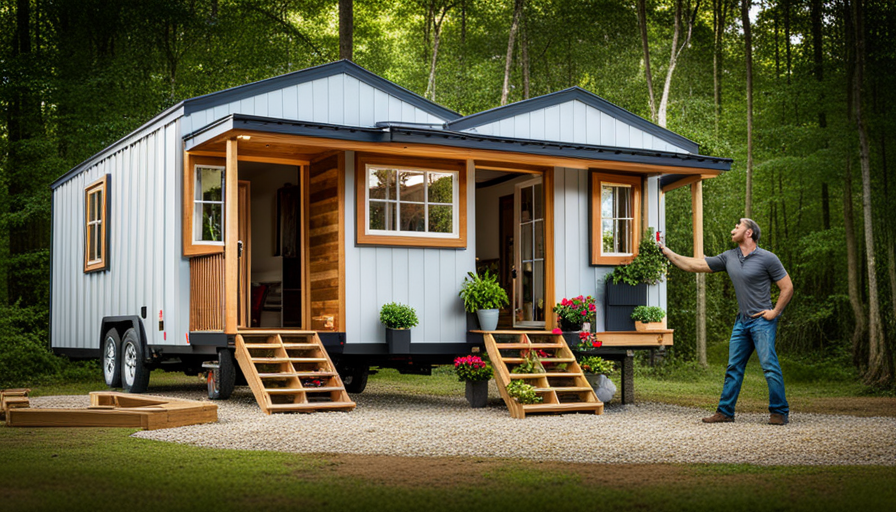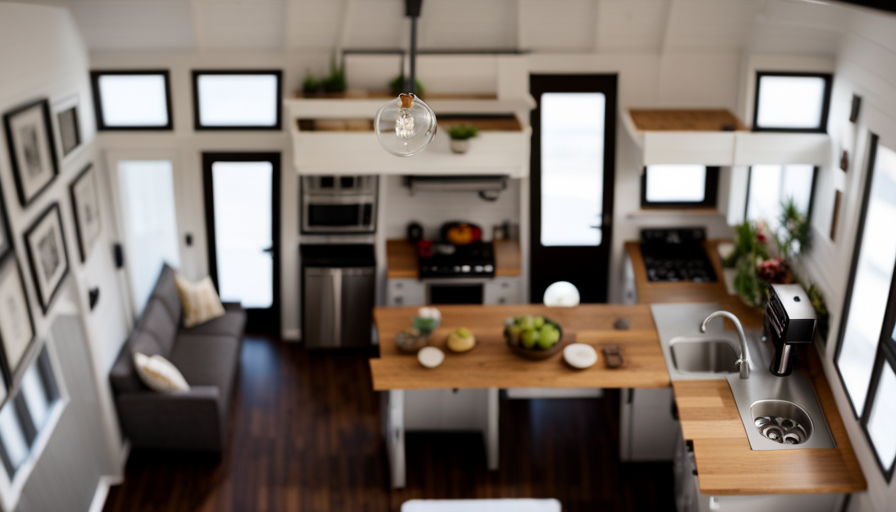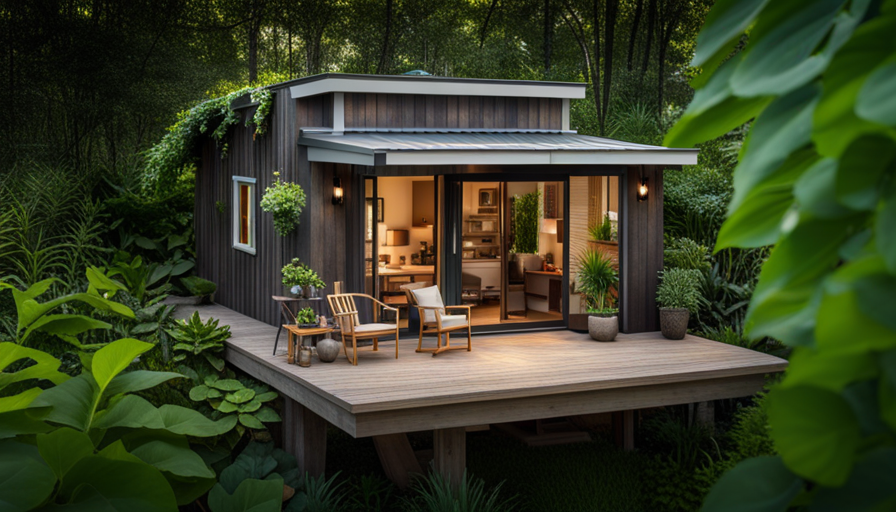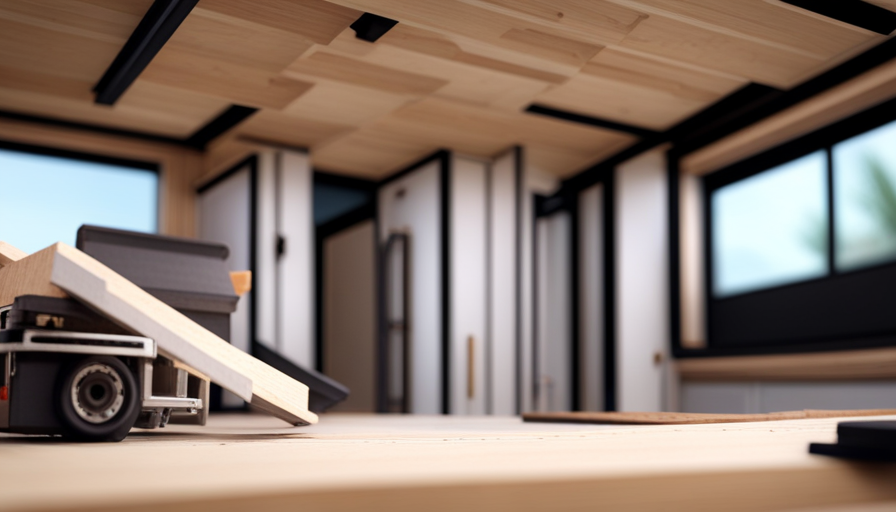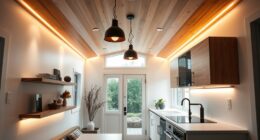Do you know the saying, ‘Good things come to those who wait’? In a similar vein, the idea of tiny houses fully embraces this concept, proving that big value can come in small packages. These small homes have quickly become a worldwide trend as a unique and practical solution to the growing struggle of affordable housing.
But what exactly defines a tiny house? In this article, I will delve into the intricacies of these compact abodes, exploring their size and dimensions, functional spaces, design and architecture, and even the legal considerations surrounding them. From their maximum square footage to their use of sustainable materials, tiny houses embody a minimalist lifestyle that has captured the hearts of many.
Whether you’re looking to downsize, embrace a more sustainable way of living, or simply have a cozy retreat of your own, understanding how a tiny house is defined is the first step in joining this growing trend in minimalist living.
Key Takeaways
- Tiny houses are a unique and innovative solution to the housing crisis, characterized by small size, compact dimensions, and space maximization.
- They incorporate multi-functional furniture and clever storage solutions, aiming to promote a simplified and clutter-free lifestyle within their limited square footage.
- Tiny houses prioritize energy efficiency and sustainability, with features such as off-grid living options, energy-saving techniques, and the use of sustainable materials.
- Living in a tiny house offers financial benefits, including lower construction and maintenance costs, decreased utility bills, and savings on mortgage or rent payments, while also contributing to a smaller carbon footprint and a more sustainable way of life.
Size and Dimensions
Tiny houses are defined not only by their small size and compact dimensions but also by their ability to maximize space and functionality. When it comes to size, there are varying regulations that determine what qualifies as a tiny house.
In some places, a tiny house is classified as a dwelling that is less than 400 square feet, while in others, it may be as small as 100 square feet. These regulations often take into consideration factors such as height, length, and width.
Despite the limited square footage, tiny houses can still offer a comfortable and livable space. Interior design ideas for tiny houses focus on utilizing every inch of available space efficiently. This can include incorporating multi-functional furniture, such as beds that fold up into the wall or tables that can be tucked away when not in use. Additionally, clever storage solutions, like hidden compartments and built-in shelves, are key to maximizing space.
Transitioning into the next section about maximum square footage, it is important to note that while there are regulations that define the size of a tiny house, there is also a growing trend of tiny houses that push the boundaries and exceed these limitations. These larger tiny houses still prioritize compactness and efficiency but offer more square footage for those who desire a bit more space.
Maximum Square Footage
Although compact, tiny houses have a maximum square footage that allows for efficient and minimalistic living. These small dwellings are designed to have a small footprint, maximizing the use of space while minimizing the impact on the environment.
A tiny house typically ranges from 100 to 400 square feet, with some even smaller or slightly larger. The limited square footage encourages creativity and innovation in utilizing every inch of space.
When it comes to tiny houses, cost effectiveness is a major consideration. With a smaller size, these homes require fewer materials to build and less energy to heat and cool. This translates to lower construction and maintenance costs, as well as reduced utility bills. Additionally, the smaller size allows for easier maintenance and cleaning, saving both time and effort.
In terms of livability, the maximum square footage of a tiny house may seem restrictive, but it actually promotes a simplified and clutter-free lifestyle. By carefully choosing the essentials and optimizing storage solutions, every nook and cranny can be utilized effectively. The functionality and layout of a tiny house are crucial to making the most of the available space.
Transitioning into the subsequent section about functional spaces and layout, it’s important to consider how these aspects contribute to the overall livability and comfort of a tiny house.
Functional Spaces and Layout
When it comes to living in a small space, you’ll find that functional spaces and a well-thought-out layout are essential for creating a comfortable and efficient home. In a tiny house, every square inch counts, so it’s crucial to make the most of the available space. Functional design and space optimization are key considerations in designing a tiny house.
To maximize functionality, each area of a tiny house should serve multiple purposes. For example, a dining table can double as a workspace, and a sofa can have built-in storage underneath. Additionally, utilizing vertical space is essential. By incorporating tall shelves, lofted beds, and wall-mounted storage, you can make the most of the limited floor space.
Another important aspect of a tiny house layout is creating distinct zones for different activities. This helps to define each space and prevent it from feeling cramped. Cleverly designed layouts can include a living area, kitchen, bathroom, and sleeping loft, all within a compact footprint.
When designing a tiny house, it’s crucial to consider the flow and functionality of the space. The layout should be intuitive and practical, ensuring that daily activities can be carried out with ease. By taking into account the needs and lifestyle of the occupants, a well-designed tiny house can provide all the necessary amenities and comfort while still being compact and efficient.
With a focus on functional spaces and a well-thought-out layout, the next section will delve into the design and architecture of a tiny house.
Design and Architecture
The design and architecture of a well-crafted tiny home can transport you to a world of limitless possibilities, where every nook and cranny holds the potential for extraordinary living experiences. When it comes to interior design, creativity and innovation are key in maximizing the limited space.
Clever storage solutions, such as built-in cabinets and multi-functional furniture, help to make the most of every square inch. The layout is carefully planned to optimize functionality, with a focus on creating distinct zones for different activities, such as sleeping, dining, and working.
In terms of exterior aesthetics, tiny homes come in a wide variety of styles, ranging from sleek and modern to cozy and rustic. The design often reflects the owner’s personal taste and lifestyle. Many tiny homes feature unique architectural elements, such as large windows to maximize natural light or skylights to bring the outdoors inside. The use of sustainable materials and energy-efficient design principles is also common in tiny home architecture.
Transitioning to the next section about mobility and portability, the design and architecture of a tiny home must also take into consideration the need for easy transportation.
Mobility and Portability
Imagine the freedom of being able to take your home with you wherever you go, seamlessly blending into new environments and experiencing life on the move. This is one of the key features of tiny houses: their mobility and portability. Tiny houses are designed to be easily transported from one location to another, making them a perfect choice for those who desire a nomadic lifestyle or simply want the flexibility to move their home whenever they please.
Here are three aspects that highlight the mobility and portability of tiny houses:
-
Lightweight construction: Tiny houses are typically built using lightweight materials, which makes them easier to tow and transport. This allows owners to easily move their homes without requiring heavy-duty vehicles or specialized equipment.
-
Trailer foundation: Many tiny houses are built on trailers, which not only provides a solid foundation but also makes them legally classified as recreational vehicles. This means they can be towed by a regular vehicle, making transportation more convenient.
-
Off-grid living options: Tiny houses often incorporate off-grid living options, such as solar panels and composting toilets. These sustainable features enable owners to live independently from traditional utilities, making it easier to find suitable locations for their tiny homes.
With their transportation challenges and off-grid living options, tiny houses offer a unique and adaptable living experience. Now, let’s explore how these homes also prioritize energy efficiency.
Energy Efficiency
When it comes to tiny houses, there’s so much more to consider than just mobility and portability. One important aspect that can’t be overlooked is energy efficiency.
Tiny houses are known for their small size, which means they require less energy to heat and cool compared to traditional houses. However, there are also specific energy-saving techniques that can be incorporated into the design of a tiny house to further enhance its energy efficiency.
One such technique is the use of insulation materials. By using high-quality insulation materials, tiny house owners can create a tight seal that prevents air leakage and minimizes heat transfer. This not only helps maintain a comfortable temperature inside the house but also reduces the need for excessive heating or cooling, saving energy and reducing utility bills.
In addition to insulation, there are other energy-saving techniques that can be implemented in a tiny house. These include using energy-efficient appliances and LED lighting, installing solar panels for renewable energy generation, and optimizing natural light and ventilation.
Transitioning into the subsequent section about the use of sustainable materials, it’s important to consider the environmental impact of the materials used in the construction of a tiny house.
Use of Sustainable Materials
To make your tiny house more eco-friendly, consider using sustainable materials that are like a breath of fresh air for the environment. By incorporating sustainable materials into the construction of your tiny house, you can greatly reduce its environmental impact. Here are five construction techniques and materials that can help you achieve a more sustainable tiny house:
-
Recycled materials: Incorporating recycled materials such as reclaimed wood, salvaged windows, and repurposed fixtures not only reduces waste but also adds a unique charm to your tiny house.
-
Natural insulation: Opt for natural insulation materials like sheep’s wool or cellulose insulation, which are not only eco-friendly but also provide excellent thermal performance.
-
Low VOC paints and finishes: Using low or zero VOC (volatile organic compounds) paints and finishes helps improve indoor air quality while minimizing harmful emissions.
-
Sustainable flooring: Choose sustainable flooring options like bamboo or cork, which are renewable and have a lower environmental impact compared to traditional hardwood.
-
Energy-efficient windows: Install energy-efficient windows with double or triple glazing to minimize heat loss and maximize natural light.
By incorporating these sustainable materials and techniques into your tiny house, you can create a more environmentally friendly and energy-efficient living space. Transitioning into the subsequent section about the minimalist lifestyle, it’s important to note that sustainable materials are just one aspect of embracing a more eco-conscious way of living.
Minimalist Lifestyle
Embrace a minimalist lifestyle and experience the joy of living with less. The tiny house movement has gained popularity in recent years due to its focus on simplicity and sustainability. Living in a tiny house allows you to downsize your belongings and prioritize what truly matters to you.
By embracing a minimalist lifestyle, you can eliminate the clutter and excess that often weighs us down in larger homes. There are numerous benefits to living small. Firstly, a tiny house is much more affordable than a traditional home, allowing you to save money and live debt-free. Additionally, the smaller space requires less energy to heat and cool, reducing your carbon footprint. Living in a tiny house also encourages you to spend more time outdoors, as the limited indoor space encourages you to utilize outdoor living areas.
Transitioning to a minimalist lifestyle and living in a tiny house may require some adjustments, but the rewards are worth it. As we move on to legal considerations and zoning laws, it’s important to understand the regulations surrounding tiny houses and how to navigate them effectively.
Legal Considerations and Zoning Laws
Navigating the legal maze of zoning laws can be daunting, but understanding the regulations is crucial to creating a sustainable and secure living situation. When it comes to tiny houses, there are several legal restrictions that need to be considered. These restrictions can vary depending on the location and jurisdiction.
One common restriction is the minimum square footage requirement for a dwelling. Many areas require a minimum square footage for a house to be considered habitable, which can pose a challenge for tiny house enthusiasts. Additionally, some communities have restrictions on where tiny houses can be placed, such as prohibiting them in certain neighborhoods or requiring them to be part of an approved tiny house community.
It is important to research and understand these restrictions before embarking on building or purchasing a tiny house. By doing so, you can ensure that your tiny house is compliant with the local laws and regulations, avoiding potential legal issues in the future.
Transitioning to the next section, the popularity and growing trend in minimalist living is evident in the increasing number of people opting for tiny houses as a sustainable and affordable housing option.
Popularity and Growing Trend in Minimalist Living
The rise of minimalist living can be seen in the increasing number of individuals choosing compact and efficient dwellings, reflecting a shift towards a simpler and more sustainable lifestyle. One manifestation of this trend is the growing popularity of tiny house communities. These communities provide a supportive environment for those who embrace minimalist living, allowing them to connect with like-minded individuals and share resources and ideas.
Living in a tiny house offers a range of financial benefits. The reduced size of these homes means lower construction and maintenance costs. Additionally, tiny homes require less energy to heat and cool, resulting in decreased utility bills. Many individuals also find that downsizing their living space allows them to save money on mortgage or rent payments. This financial freedom allows them to pursue other interests and experiences that bring them joy and fulfillment.
In addition to the financial advantages, minimalist living in a tiny house promotes a more sustainable lifestyle. These homes typically have a smaller carbon footprint compared to larger, traditional houses. They often utilize eco-friendly materials and energy-efficient appliances. Furthermore, the limited space encourages individuals to be mindful of their consumption habits and to prioritize quality over quantity.
Overall, the growing trend of minimalist living in tiny houses reflects a desire for a simpler, more sustainable way of life. By choosing to live in compact and efficient dwellings, individuals can not only save money but also contribute to the preservation of our environment.
Frequently Asked Questions
What are the necessary permits and regulations for building a tiny house?
Permit requirements and zoning regulations are crucial when building a tiny house. To ensure compliance, it’s important to research and understand the specific requirements of your local jurisdiction. Contacting the local building department is essential to determine the necessary permits needed for construction.
These permits may include building permits, electrical permits, plumbing permits, and more. Additionally, zoning regulations dictate where tiny houses can be located, such as in specific zones or as accessory dwelling units on existing properties. Adhering to these regulations is vital to avoid any legal issues.
Are there any restrictions on where I can park or place my tiny house?
There are certain restrictions and regulations when it comes to parking or placing a tiny house. These restrictions vary depending on the location and local zoning regulations. It’s important to check with your local authorities to determine if there are any specific parking restrictions for tiny houses in your area.
Zoning regulations may also dictate where you can park or place your tiny house, such as in designated residential areas or on private property with the owner’s permission.
Can a tiny house be connected to utilities like water, electricity, and sewage?
Yes, a tiny house can definitely be connected to utilities like water, electricity, and sewage. It’s like plugging into the grid, but on a smaller scale.
There are various ways to connect utilities, depending on the design and location of the tiny house. Some people choose to have their tiny house connected to the existing grid, while others opt for off-grid options like solar panels, rainwater harvesting, and composting toilets.
It’s all about finding the right balance between convenience and sustainability.
Is it possible to customize the design and layout of a tiny house to meet my specific needs?
Yes, it’s absolutely possible to customize the design and layout of a tiny house to meet your specific needs. There are numerous customization options available, allowing you to personalize your tiny house according to your preferences. From choosing the materials and finishes to deciding on the layout and room sizes, you have the freedom to create a space that suits you perfectly.
Space optimization is also a key consideration, ensuring that every inch of your tiny house is maximized for functionality and comfort.
What are some common challenges or disadvantages of living in a tiny house?
Living in a tiny house can present a range of challenges and disadvantages. For instance, limited space can make it difficult to store belongings or have privacy. Maintaining organization and cleanliness can also be a constant struggle. Additionally, the lack of space may restrict the number of guests you can comfortably accommodate. These challenges require careful planning and adjustment to ensure a fulfilling tiny house lifestyle.
Conclusion
In conclusion, the definition of a tiny house goes beyond its physical attributes. It represents a lifestyle choice that embraces simplicity, sustainability, and freedom.
Just like a small seed that grows into a majestic tree, a tiny house allows individuals to cultivate their dreams and create a life of their own design.
With the rising popularity of this movement, it’s clear that people are yearning for a more meaningful and intentional way of living.
So, whether you choose to dwell in a tiny house or not, may you always remember the power of embracing a minimalist mindset and nurturing your own growth.
Hi, I’m Emma. I’m the Editor in Chief of Tiny House 43, a blog all about tiny houses. While tree houses are often associated with childhood, they can be the perfect adult retreat. They offer a cozy space to relax and unwind, surrounded by nature. And since they’re typically built on stilts or raised platforms, they offer stunning views that traditional homes simply can’t match. If you’re looking for a unique and romantic getaway, a tree house tiny house might just be the perfect option.



